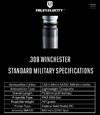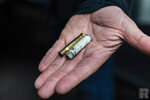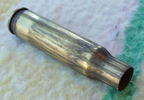Thoughts? I wonder if it will be reloadable.
https://www.americanrifleman.org/content/saami-certifies-first-composite-cased-round/
https://www.americanrifleman.org/content/saami-certifies-first-composite-cased-round/



 www.guns.com
www.guns.com
At this point, the main advantage is lighter weight, something that is mainly important to the military.
From what is publicly available, the US Military has yet to choose a 6.8mm cartridge. The advertising from True Velocity and SIG has been confusing, but the fine print actually says that the cartridges were adopted for the trials, not full scale military use. From what I have read there have been enough issues with both the polymer 6.8 TVCM and SIG's 6.8mm hybrid that there is no clear winner. There were some accuracy issues with the polymer round and the bullpup rifle submitted with it was not well liked. The polymer round should be lighter and cheaper than either brass or the hybrid brass/steel case if high production levels are ever reached.There has always been an advantage to brass in that you could take brass fireformed in you specific chamber in precision bolt guns and only neck size your reloads. But my understanding of the major advantage in composites, and why the military is adopting the composite in their new machine guns is that they allow guns like the bravo to run cooler. Composites are in essence a heat insulator for the chamber and barrel. The 6.8 they have adopted gives down range ballstic performance will a simple barrel swap.

$3.50 a round is steep. I just can not justify it when brass/reloadable ammunitions can be had or a third the price. I get that it makes sense for the military and they can buy enough to drive the price down, when they do I may try a box.
Hey John, serious question because I don't know: are the advantages of the fluted chamberThe advantage they will have is set a market price and drive down to that price. This is what a government contract does for a company like them. The ability to buy futures in the supply chain will help alot and I hope this goes forward. Because the metal part of the case is magnetic and I hate picking up brass...
As far as dirty or not, it will only matter if two things have ot happen.
1. Cleaner powder
2. Fluted chambers
I could see where a fluted chamber "could" do wonders for these rounds in the extraction and reliability.
I am not John, but the short answer is that it makes case extraction easier and prevents the extractor from ripping the rim off or just slipping off the rim.Hey John, serious question because I don't know: are the advantages of the fluted chamber
Correct,I am not John, but the short answer is that it makes case extraction easier and prevents the extractor from ripping the rim off or just slipping off the rim.
Longer answer: With a regular chamber, the pressure from firing causes the case briefly to expand and press against the chamber walls. With most gas-operated actions, there is enough delay between firing and extraction that the chamber pressure has time to drop and the friction between the case and chamber walls is reduced enough that the case can slide backwards relatively easily. When people talk about getting the "timing" right on an AR15, they are talking about getting this delay right.
With some other types of action, like delayed blowback, the case begins moving back earlier, while the chamber pressure is high enough that the case is still pressed hard against the chamber wall. This can result in the extractor tearing the rim or the case. Sometimes, the extractor just slips off the rim.
The flutes cut into the chamber gives paths for some of the high-pressure gas to get between the chamber wall and the case, equalizing the pressure on the case walls somewhat and keeping the case from being pressed as hard against the chamber wall and sticking.



